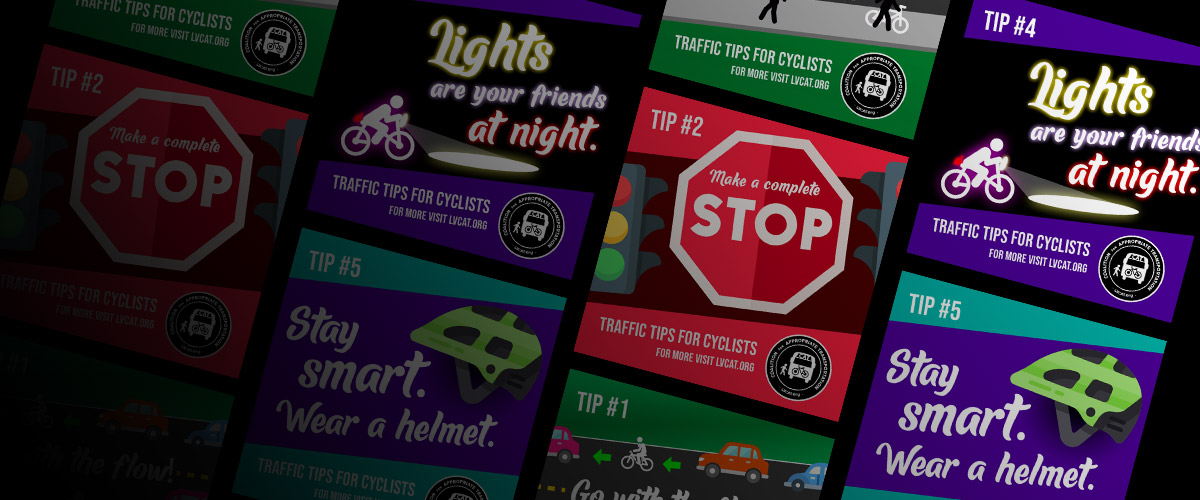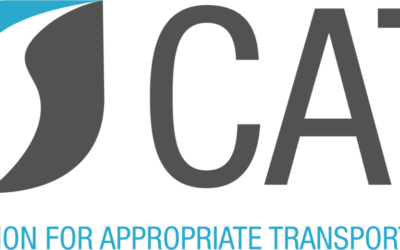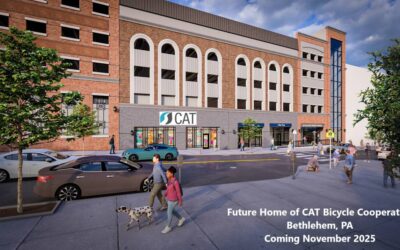One development of our coronavirus-inspired isolation is that more people are riding their bicycles, on both the trails and the roads. This makes sense — LVPC and PennDOT data show there are far fewer cars on the road; exercise helps with both the physical and mental challenges of being mostly confined to our homes; and cycling is a cheap means of transport that keeps us at a safe distance from others.
Many of the riders we see now appear to be relatively new to two-wheeled travel — many are riding older, squeaky bikes. Ordinarily, we would encourage new riders to sign up for CAT’s basic bike safety and mechanic classes, but the CAT Bicycle Cooperative is currently limited because of the requirements of physical distancing (We are open for sidewalk appointments only). Nonetheless, we want to offer a few tips for safety and even — dare we say it in these times? — enjoyment.
Whether you are riding on the roads or the trails, before you head out, do a basic check of your bike mechanics. At CAT, we teach the ABC Quick check: A is for air in your tires; B is for brakes; C is for your cables and chain; and Quick is for the quick release levers on your wheels. Many problems can be easily resolved by a bit of lube. Even if your bicycle has been sitting unused in your garage or basement for years, it’s simple to lubricate the chain and other moving parts (exception: DON’T lubricate the brake pads, the part that goes onto the rim of the wheel.) Your bike tires show the max PSI (air pressure) on the sidewall, for example “40-65 PSI max.” Use that guideline to pump air and you’ll be fine. If your pump doesn’t show PSI, pump until the tire is firm. Another easy fix that affects how comfortably you ride is the height of your seat. As a basic rule of thumb, your seat should be high enough that when you are seated and pedaling at the lowest point of your pedal stroke, you have only a slight bend in your knee. This allows you full use of your upper leg muscle and eases strain on your knees.
When riding on the roads, here are a few things to keep in mind:
RIDE WITH TRAFFIC: Ride on the right side of the road. As a bicyclist, you are bound by the Pennsylvania motor vehicle code. You are most visible to other road users when you are obeying the general flow of traffic than if you strike out on your own. If you get nervous at not knowing what’s coming behind you, practice “scanning” — turn your head over your left shoulder to look behind you while continuing to steer your bike straight; or get a mirror on your handlebar; or simply always assume that there are cars coming up behind you. Lately, we’ve noticed a number of adults riding their bicycles on the sidewalks. Unless you are under age 12, this is not legal in business districts; nor is it safe, given that the sidewalks are used by walkers, and that you cannot be seen by other drivers at intersections, driveways, and other points of motor vehicle/bicycle conflict.
FOLLOW ALL TRAFFIC SIGNS AND SIGNALS: Yes, that means you must stop at all red lights and stop signs, just as you would if driving a motor vehicle. At stop signs or red lights, do not squeeze past stopped vehicles ahead; even though physically it’s possible to move ahead this way, you are safer by keeping your place in line, because you don’t risk getting hit by a vehicle ahead of you turning right. When you are turning left at an intersection, get in the left hand turn lane where there is one, and wait your turn like all the other vehicles around you.
UNDERSTAND IDEAL ROAD PLACEMENT: The safest place for you to ride is on the part of the road that is a little to the left of the white line. While the gutter or shoulder of the road might feel safer because you’re more out of the way, you are less visible to other road users if you ride the shoulder. On roads where there are parked cars, ride far enough away from parked cars to be out of range of any suddenly opened car doors. Also, ride in a steady straight line, not weaving in and around parked cars, because by riding in a straight line as far out on the road as you need to be to avoid the “door zone,” you are most visible and predictable to other road users. Legally, you are as much a vehicle and rightfully on the road as any drivers. Don’t let a driver with a horn bully you into an unsafe place on the road.
BE SEEN: Day or night, be visible. Wear bright clothing. If you’re cycling at night, or in dim light, both the law and common sense require that you use a red light on the rear of your bike and a white headlight on the front. These items have become cheaper and more reliable as technology has improved over the last few years.
COMMUNICATE: Your predictability enhances your safety. When you are going to make a turn, signal your intent to other road users — fully extend your left or right arm, to show a left or right turn. Likewise, signal if you are switching lanes for any reason. If you are stopping suddenly for a pothole or a pedestrian crossing, signal that to other drivers by holding your left hand down, palm backward.
HELMETS: “A helmet is a bargain in injury prevention” (John S. Allen, “Street Smarts – Bicycling’s Traffic Survival Guide”, Rodale Press). For the price of a helmet $20-100, significant protection is available to protect one’s brain. While a helmet doesn’t prevent all head and neck injuries, there is data that it can do a lot (https://helmets.org/). If your curious which helmets rank best, read Virginia Tech’s study results here (https://helmet.beam.vt.edu/).
TRAILS: As for riding on the trails, ride a safe speed for the trail conditions. When you want to pass walkers or runners and there’s room to do so, approach slowly, and say loud enough to be heard “passing on your left.” Remember, many trail users won’t hear because they are wearing headphones or earbuds, so proceed cautiously when passing. On a narrow trail, walkers have the right of way over bicyclists, so when you come upon a walker, pull over at least 10-20’ away to give the walker a chance to step off the trail at a safe distance. Right now, trail use is high; it’s best to wear a mask even when you are bicycling, as it may not always be possible to maintain the recommended distance from your fellow trail users.
Last of all, whether you are riding the roads or the trails, we hope you will find, as we do, that the simple pleasure of riding a bike remains as much a fact today as in more normal times. Stay safe!
Written by Anne Felker, bicycle safety educator and board member of CAT- Coalition for Appropriate Transportation and Scott Slingerland, Executive Director of CAT












0 Comments